Uncanny X-Men Part 6: Issues #49-53: Reunion and Family and Steranko
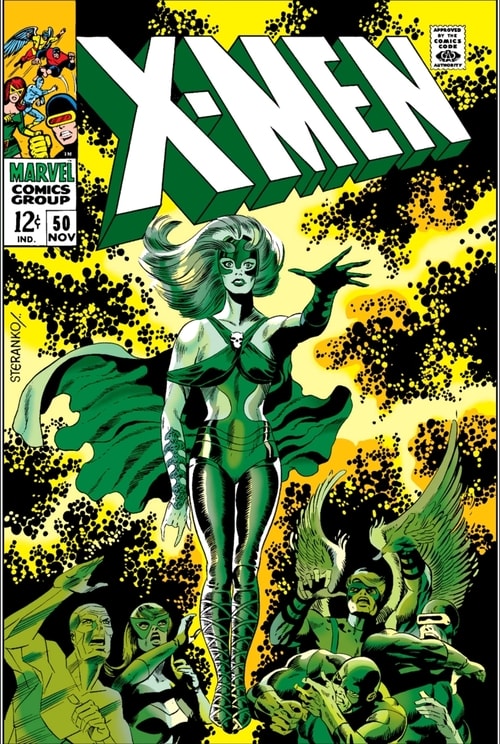
Holy mutants, Batman! We’ve reached week 12, episode 6 of the great X-Men reread! This is an exciting run, because we get to experience the first of two moments of major artistic experimentation in the Silver Age X-Men, as well as the first real addition to the X-Men’s roster since issue #1. This blog post will only cover the 4-issue Daughter of Magneto saga and a stand-alone issue with an FF villain (so October, 1968 to March 1969), but I think we’re getting to periods where it’s worth slowing down to experience the art and writing more slowly.
We left the X-Men at the end of issue #48, having been split up for two issues and still mourning their deceased professor. By the time issue #49 rolled around, we readers were ready to see the gang back together. Their reunion feels like a big deal not just because they’re together again, but because of the cover art and the new story.
With a 2020 sensibility, we can look back and say that the first Steranko X-Men cover was a big deal, but we often forget that Steranko was a big deal even in the summer of 1968. Jim Steranko’s art didn’t look like anything else out there. He’d been consistently creating the visual voice of Nick Fury, Agent of S.HI.E.L.D. in Strange Tales all through 1967, importing a bunch of pop culture elements into that look. Steranko’s art is worth its own blog post.
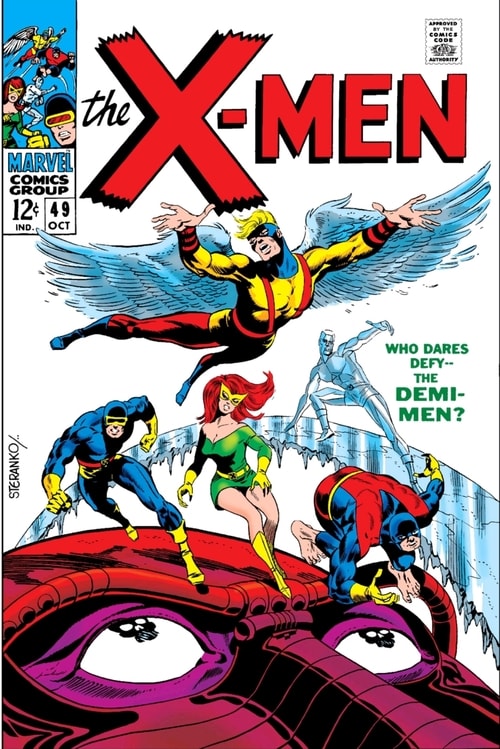
Steranko brought a hip sensibility to his two X-Men issues (#50-51 interior art, plus covers on #49-51). He obviously took some cues from Kirby, with the energy of his composition and his visual inventiveness, but he brought in interesting techniques in his short time at Marvel. Steranko’s total comic output doesn’t feel like a lot but we have to remember that he was drawing comics in the middle of the night.
Steranko worked in an ad agency during the day, played in a band at night (I heard him say in an interview that he came up with the idea for go-go dancers to give his band a competitive advantage), and drew in the night hours between the two. His design and advertising daring shows in everything he draws. The first image in the post is Steranko’s second X-Men cover. You can see he’s already replaced the god-awful jagged lettering that the title suffered through for 49 issues. Steranko’s X-Men logo would persist all the way into the Claremont/Lee era and beyond.
This is also the first full set of stories we’re looking at with Arnold Drake as writer. After Roy Thomas’ last writing credit on X-Men #44, a few people pitched in, including Gary Friedrich, who write the two issues of the split-up X-Men. We know Friedrich of course because of his co-creation of Bronze Age horror characters like Son-of-Satan and Ghost Rider.
But Drake writes the 4-issue Silver Age mini-saga, with Don Heck and Werner Roth on art. They create the powerful mutant Mesmero, who leads a cult that worships Magneto. Mesmero’s plan is to stimulate the powers of people who have mutant genes to bring them to their full power. Once in that state, Mesmero can control them. As far as nonsense villainous plans go, this one actually makes sense, so A+ for Drake!
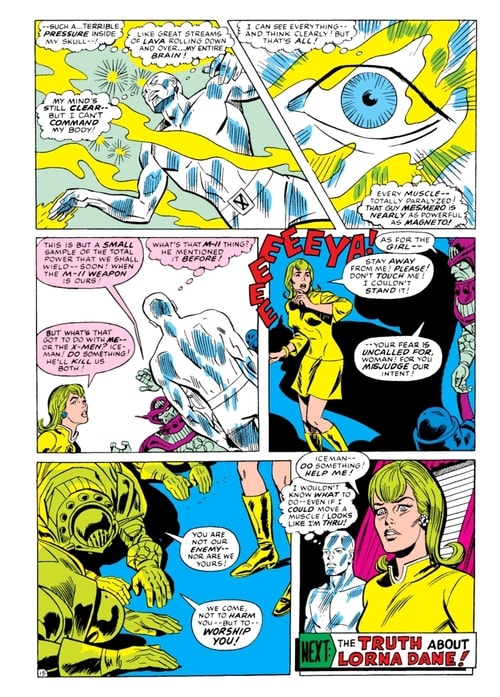
Their plan snares Lorna Dane, who is prevented from following Mesmero’s signal by a love-struck Bobby Brake. Mesmero’s people come to get Dane specifically, which seems weird, and after laying the beats on Iceman, it gets real weird as they kneel in worship of Dane! This is a lot of twists and turns and originality for this book considering some of the sub-standard stories we’ve seen, and I felt that this story was hitting the same highs as the X-Men-Avengers cross-over, and overshadowing the Factor Three story.
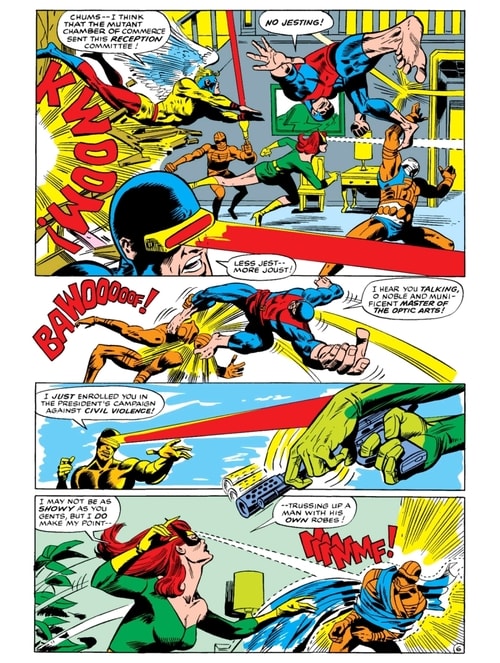
You can see Steranko’s style and energy in these images of interior art for X-Men #50. I tend to care a lot about draftsmanship, so sometimes I feel that his X-Men work had some unevenness, but I love his experimentation with perspectives and shading, with slim, lithe figures. It really is like nothing else we were looking at yet.
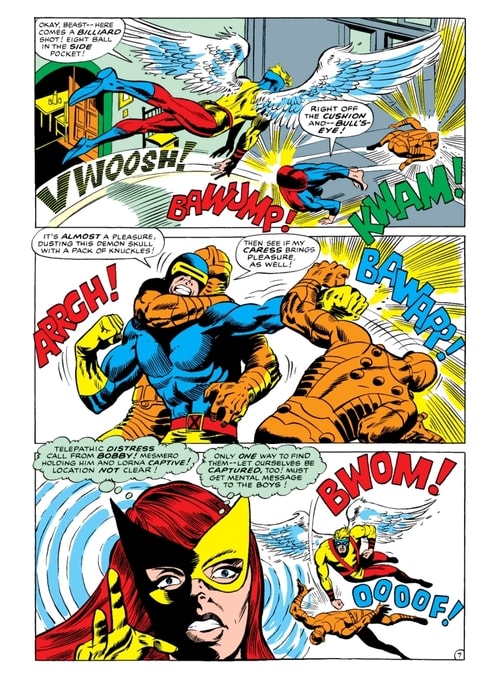
Steranko’s vivid imagination was Kirvy-esque in its explosiveness. His action is at times wild and physical and at times surreal. As I’d read, I’d been wondering how much influence he had on the coloring, which obviously have to do interesting work to support his stylistic innovations. Very interestingly, I heard Steranko say in interview that he’d colored some of them, although he couldn’t remember exactly. As well, it is established that he colored some of the covers her did, and he was doing some interior coloring in his Strange Tales work.
More than that, and probably more importantly, I’ll say that we’re seeing some of the first modern breakdown of panel layout page structures in the X-Men. We’ll look at this a lot more in my next blog post, where another ground-breaking artist makes his mark on the X-Men, but as you can see in the page below, the blocky panel structure that dominated since before Action Comics #1 is being busted with an inset panel, some neat lettering placements and then some eye-catching composition in the bottom 2/3 of the page.
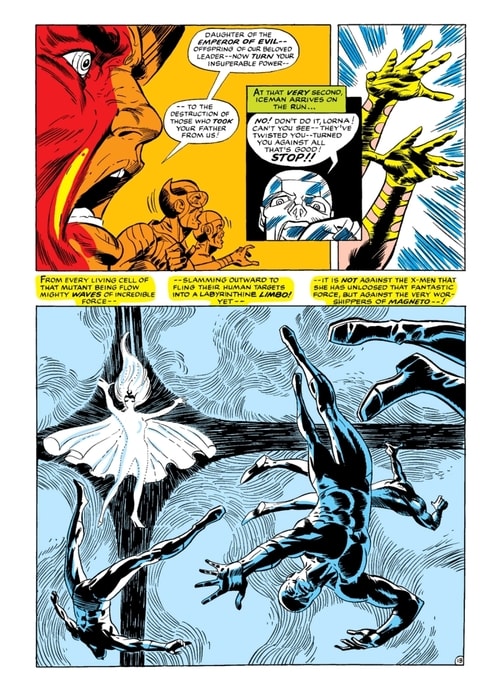
The X-Men go in to rescue Lorna Dane, but they don’t get there before she emerges from Magneto’s mutant-accelerator with her full powers and is revealed to be daughter of Magneto, who is intended to be empress of the mutants. Again, Drake’s plotting is wonderful – the lost daughter twist was great.
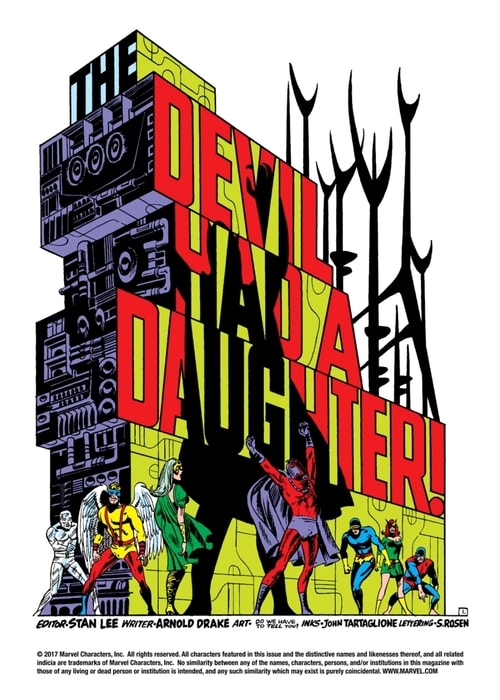
The Daughter of Magneto saga runs until #52 and is very fun, showing the origin of the mutant who will join the X-Men later as Polaris. Her entry to the X-Men is a big deal. Since X-Men #1 it’s been just the five original mutants, except for a couple of issues when the Mimic was sort of a member, but that was almost like a problem of the week story. Lorna Dane is legitimately and permanently the 6th X-Man.
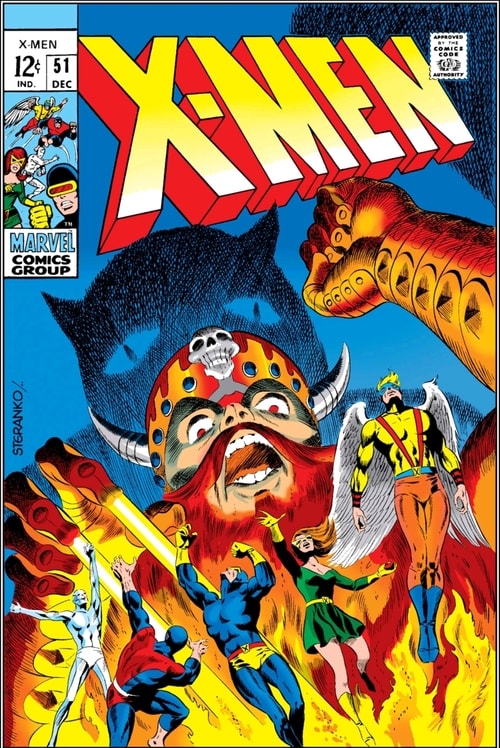
Let that sit with you for a second. Lorna Dane was the 6th X-Man. Can you imagine living in a time when there were only six X-Men?? Even though I’m reading it, I’m having trouble with it, having grown up in the Claremont era when we added The New Mutants, the Morlocks, the Hellfire Club, the Maurauders, etc, etc. And I don’t think anyone in 1968 could have imagined a time when Marvel comics would have enough mutants to form a nation.
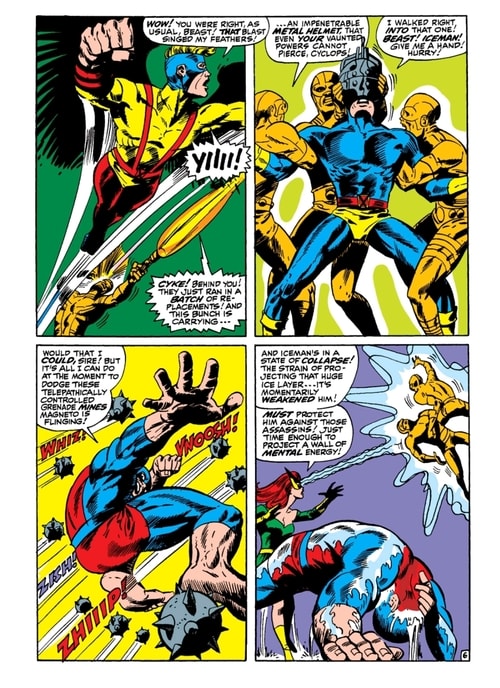
So the 4-part Daughter of Magneto story is a lot of fun, and the X-Men fight Blastaar in issue #53. It’s a monster-of-the-week issue that ends with Blaastar back in the Negative Zone with no change in the status quo. The plot is forgettable, but the issue is historically relevant.
Firstly, Barry Smith, the famous Bronze Age Conan artist pencils the issue, in a style that is slavish in its honouring of Kirby (cover above is an example), but nonetheless has some visual charm. Secondly, the 5-page X-Men origin back-up stories that have been running since the 1966 has gotten to the origin of Beast and I’ve always appreciated these looks at the characters prior to X-Men #1.
That marks the end of where I wanted to go with this post. In two weeks, we’ll start with issue #54, an important story because it begins what most readers (including me) would call the high water mark of the Silver Age X-Men. We’ll get a 7th x-man, meet the Living Pharoah, Sauron, and look at the art of Neal Adams’ spectacular run.
If you want to catch up on any of my other posts about the X-Men, they’re below:
- Part 0: A Fresh Look at X-Men Continuity: Ed Piskor’s Grand Design
- Part I: Introducing The Strangest Super-Team of All: Uncanny X-Men #1 (Nov 1963) to #20 (May 1966)
- Part II: Early Guest Appearances (1964-65), Uncanny X-Men #21-23 (1966), and X-Men: First Class Volume I (2006)
- Part III: X-Men: First Class, Volume II (2007) and First Class Finals
- Part IV: Uncanny X-Men #24-39: The Middle Years of the Original Team
- Part V: Uncanny X-Men #40-48: Death and Separation
- Part VI: Uncanny X-Men #49-53: Reunion and Family and Steranko
- Part VII: Uncanny X-Men #54-58 — Havok and Neal Adams
- Part VIII: Uncanny X-Men #59-66: The Savage Land and the End of the Silver Age X-Men
- Part IX: Filling in the Corners of the Original X-Men with Savage Hulk #1-4
- Part X: John Byrne’s The Hidden Years #1-4
- Part XI: Storm, the FF and Phoenix in John Byrne’s The Hidden Years
- Part XII: X-Men Guest Appearances in 1971-1972 and Hank gets Furry!
- Part XIII: Englehart’s Bronze Age Monster Horror – The Beast
- Part XIV: 1973 and 1974 – Magneto, the Hulk, Banshee and post-Watergate Captain America
- Part XV: 1974 and 1975 – The Last Tales of the Original X-Men
- Part XVI: Enter Wein, Claremont and Cockrum in 1975
- Part XVII: 1976 — Sentinels in Space and the Rise of Phoenix
- Part XVIII: Juggernaut and Magneto — For the Very First Time
- Part XIX: Phoenix, Firelord and the Imperial Guard
- Part XX: Iron Fist, Blame Canada and Some Strike-Outs
- Part XXI: Epic Magneto Triumph and more X-Men Death!
- Part XXII: 1978 — The Savage Land, Japan and Psionic Throwback Thursday!
- Part XXIII: 1979 — Chaos in Canada with Alpha Flight!
- Part XXIV: Arcade, Murderworld and their First King-Sized Annual
- Part XXV: The Proteus Saga and My First Comics!
Derek Künsken writes science fiction in Gatineau, Québec. His first novel, The Quantum Magician, a space opera heist, was a finalist for the Locus, Aurora and Chinese Nebula awards and until February 17th, the ebook is on sale for 99p right here. His third novel, The House of Styx, has just been announced jointly by Solaris Books and Analog Science Fiction and Fact who will be publishing it in hardcover and serial form, respectively. Analog hits the newsstands on the 18th of February with this astounding (what a terrible pun!) cover:
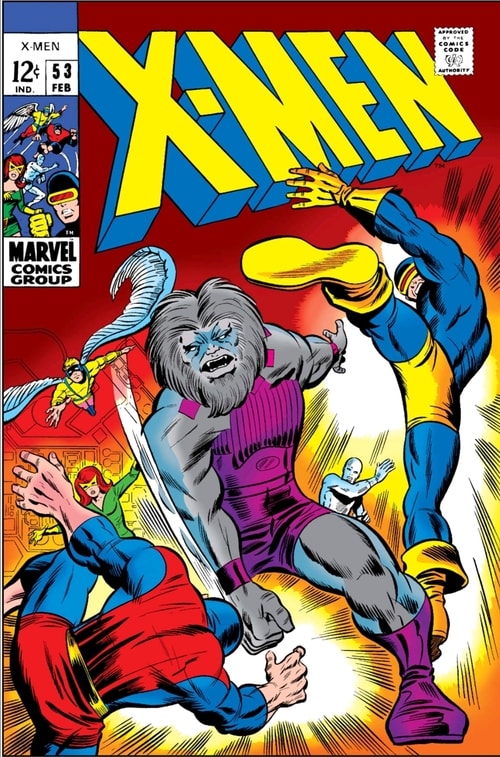
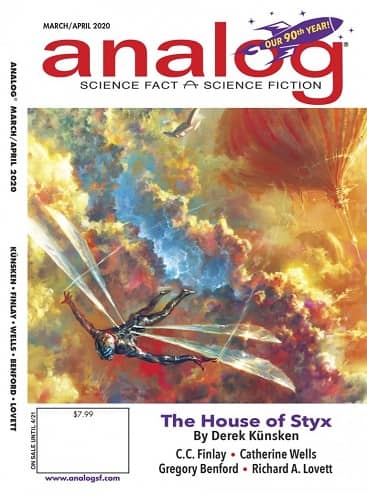
I love Steranko’s work, it hits you like a ton of bricks when it first shows up in the silver age. But he was more of an artist than a storyteller with these and his captain America issues.
Hey Glenn! Yeah – “hit” is a great description too! so much personality and style to it! My favourite part of Steranko is just the weird intricate impossible architecture he creates for his futuristic stuff.
Glenn,
I think that’s a very apt description of Steranko’s strengths. He did fantastic cover work (for comics and paperbacks), but I was often less taken with his interiors.